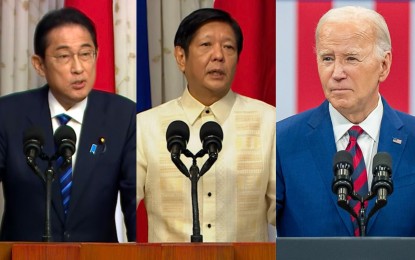
President Ferdinand R. Marcos Jr. (center), US President Joe Biden and Japan Prime Minister Fumio Kishida. (Photos courtesy of RTVM and the White House)
MANILA – The Philippines, Japan and the United States’ agreement to advance trilateral cooperation, including on defense and security, would help maintain the status quo in the West Philippine Sea, an international studies expert said Friday.
At the Bagong Pilipinas Ngayon briefing, Pacific Forum Director for Maritime Security Jeffrey Ordaniel believes that the partnership would further boost the Philippines' capacity to protect its rights within its maritime zones.
“My expectation is there will be more efficient and strategic coordination on how to better build Philippine capacity. (There will be) division of labor to make sure that China does not continue to coerce its way through domination of the South China Sea and the region,” he said.
President Ferdinand R. Marcos Jr. met with US President Joe Biden and Japanese Prime Minister Fumio Kishida for a historic trilateral meeting in Washington, D.C. on April 11.
The three leaders announced a number of new investment initiatives in various areas.
Included in the expected deliverables are “at-sea trilateral exercise” and other maritime activities between the US, Philippine, and Japanese coast guards starting next year.
At the bilateral level, Ordaniel hoped the Philippines would partner with the US in ensuring the success of future resupply missions to the Filipino troops manning the BRP Sierra Madre in Ayungin Shoal.
The analyst said the situation over the feature remains the “most urgent challenge” the country needs to face.
“It’s where China is trying to act with impunity and try to dislodge our presence there. It is time for the Philippines and the United States to discuss imposing actual costs on China,” he said.
Among Ordaniel’s suggestions is for the US to “escort the resupply mission” either as part of a joint military exercise program or in tandem with the US Navy Freedom of Navigation Operations.
“Doing so would allow us to maintain the status quo in the Second Thomas Shoal and withstand Chinese coercion,” he said.
China claims territorial sovereignty over the Ayungin Shoal but Ordaniel argued that no country can claim it as a territory because it has been classified as a “low tide elevation” under the United Nations Convention on the Law of the Sea (UNCLOS).
“Ibig sabihin niyan lumulubog siya kapag high tide. Kapag lumulubog iyan kapag high tide ibig sabihin niyan hindi siya puwedeng i-claim na territory ng kahit na sinong bansa (A feature that is submerged at high tide is called a low tide elevation. If that is the case, no country can claim it as a territory),” he explained.
Given that Ayungin Shoal only has a distance of 106.3 nautical miles (NM) off Palawan and at least 617.39 NM away from the Chinese mainland, it automatically becomes part of the Philippines’ UNCLOS-mandated 200-NM exclusive economic zone.
This grants the Philippines an exclusive right to exploit and explore resources, as well as the exclusive right to build artificial structures there, said Ordaniel.
“So kung mag-decide man ang Pilipinas na we reinforce that vessel (BRP Sierra Madre) and maybe build a structure on top of it, that’s within our rights under international law (Should the Philippines decide that we will reinforce that ship and maybe build a structure on top of it, that’s within our rights under international law),” he said. (PNA)
